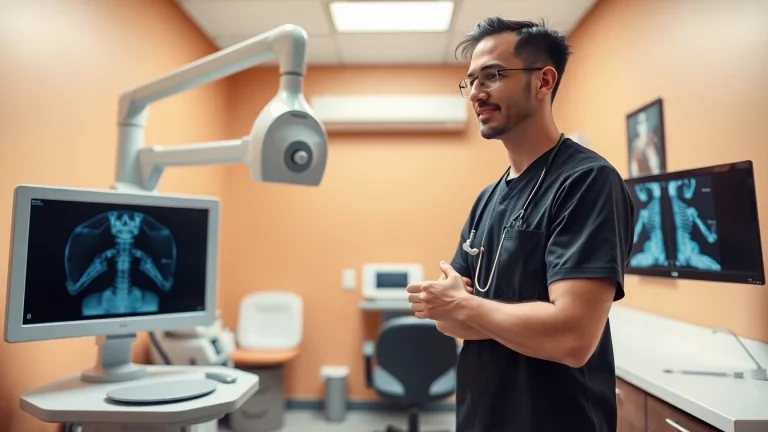
Your Guide to Trade-in Old X-ray Machine for Digital Solutions
Understanding the Benefits of Trading in Your Old X-ray Machine
As medical imaging technology continues to advance, healthcare facilities face the crucial decision of whether to upgrade their existing equipment. One of the most common dilemmas is trading in old X-ray machines for digital alternatives. This transition can improve imaging quality and streamline workflows, fostering better patient care. If you are exploring how to trade-in old X-ray machine for digital, it’s essential to understand the multitude of benefits associated with such a decision.
Why Upgrade to Digital Imaging Technologies?
Digital imaging technologies have significantly evolved, offering numerous advantages over traditional radiography systems. One of the most compelling reasons to upgrade is the superior image quality produced by digital systems. Unlike conventional film-based X-rays that can suffer from quality degradation over time, digital images provide high-resolution visuals that are more accurate, enhancing diagnostic capabilities.
Additionally, digital systems often come equipped with advanced software features, such as automatic contrast adjustment and image enhancement tools, facilitating quicker and more precise interpretations. Furthermore, with the shift towards electronic health records (EHRs), digital X-ray systems can be seamlessly integrated into existing hospital or clinic networks, improving the flow of information among healthcare providers.
Cost Savings and Increased Efficiency
The financial implications of upgrading to digital imaging can be substantial. While the initial investment may appear daunting, the long-term savings justify the transition. Digital X-ray systems reduce costs associated with film, processing chemicals, and storage. Healthcare facilities can also expect lower maintenance costs as digital systems require less frequent repairs compared to their analog counterparts.
Moreover, the increased efficiency of digital imaging translates into a higher throughput of patients. Radiologists can access and analyze images instantly without waiting for film development. This expedites the process of diagnosis and leads to quicker treatment decisions, ultimately improving patient satisfaction and outcomes.
Environmental Impact of Upgrading Medical Equipment
The environmental considerations of medical equipment use are becoming increasingly pertinent. Traditional X-ray machines rely on film and chemicals that contribute to waste, and their disposal can pose environmental risks. In contrast, digital imaging minimizes waste as it eliminates the need for hazardous materials associated with film processing.
By transitioning to a digital X-ray machine, healthcare providers not only embrace advanced technology but also demonstrate a commitment to sustainable practices. Digital imaging systems typically have lower energy consumption, reducing the overall carbon footprint of the medical facility.
The Trade-in Process Explained
Steps to Prepare Your Old X-ray Machine for Trade-In
Preparing your old X-ray machine for trade-in involves several key steps. Begin by assessing the current state of the equipment. Document any malfunctions, maintenance records, and overall working condition, as this information will be critical when negotiating trade-in offers.
Next, ensure compliance with any regulations pertaining to medical equipment disposals, as rules may vary by region. It’s advisable to consult with your local regulatory authority or a professional to navigate the appropriate measures. Clean the equipment thoroughly to present it well and avoid penalties related to contamination.
Choosing the Right Digital Model for Your Needs
Once you’ve prepared your old machine for trade-in, the next step is to identify which digital X-ray system best suits your needs. Key factors include the types of procedures your facility performs and the volume of patients treated.
Evaluate the features of various models on the market. Some units may offer advanced imaging technologies like computed radiography (CR) or direct radiography (DR), which can enhance imaging speed and efficiency. Consulting with imaging specialists can also provide insights on which models are most effective for specific applications.
Evaluating Offers from Different Suppliers
In the trade-in process, it’s paramount to compare offers from various suppliers carefully. Start by soliciting quotes that cover trade-in values alongside the prices of the new digital systems. This ensures you can assess the total cost and potential savings brought about through the transaction.
Look for reputable suppliers known for fair valuations, as some may underrepresent the value of older equipment to boost the sale of new models. It may also be advantageous to engage in negotiations to secure the best possible deal.
Challenges in Trading In X-ray Machines
Common Misconceptions About Trade-Ins
Many misconceptions surround the trade-in process for medical equipment, particularly regarding its complexities. One common myth is that all trade-ins yield significant financial benefits; however, the actual value often depends on factors such as age, functionality, and market demand.
Another misconception is that the process is typically cumbersome and overly lengthy. While the trade-in can involve several steps, a well-organized approach simplifies the process significantly and leads to swift outcomes.
Dealing with Compliance and Regulatory Issues
Compliance issues can pose daunting challenges when trade-in considerations arise. Regulations regarding medical equipment disposal vary by state and country. It is crucial to ensure that your old X-ray machine is disposed of in adherence with local laws, which may include specific documentation and recycling protocols.
Failure to comply with these regulations can lead to financial penalties or operational setbacks. Work closely with equipment suppliers experienced in the medical field to navigate any compliance-related hurdles efficiently.
Overcoming Technical Hurdles During the Trade-In
Technical challenges can arise when preparing for a trade-in, particularly with older models that may be outdated or non-compliant with current regulations. Addressing these issues may require professional technical inspections or updates that could entail further expenses.
To alleviate these concerns, consider conducting a thorough pre-trade evaluation with an experienced technician. They can help ensure the old equipment is in good working order and identify any tweaks that may enhance its trade-in value.
Best Practices for Maximizing Your Trade-In Value
Maintaining Your Old Equipment for Better Offers
Regular maintenance is crucial for maximizing the value of your old X-ray machine during the trade-in process. Keeping up with scheduled repairs, routine servicing, and adhering to the manufacturer’s recommendations can significantly enhance the machine’s condition and lifespan.
Documentation of maintenance records will bolster your negotiations, demonstrating that you took good care of the equipment. Buyers are more likely to offer higher values for machines that show reliable performance histories.
Understanding Market Trends in Medical Imaging
To make informed decisions during the trade-in process, it’s beneficial to stay updated on current market trends in medical imaging. Understanding factors such as the growing demand for specific technologies, pricing fluctuations, and the integration of innovative features can provide leverage when negotiating trade-in offers.
Engage with industry publications, attend conferences, or follow thought leaders in medical imaging to remain knowledgeable about trends and technologies. This awareness can also prepare you for potential future investments in medical imaging technology.
Negotiating Trade-In Offers Effectively
Negotiation is a critical aspect of achieving a favorable trade-in offer. Begin this process by having a clear understanding of your old equipment’s value based on your research and market analysis.
When negotiating, remain assertive yet flexible. Present data to support your request for a higher trade-in price and be prepared to engage in back-and-forth discussions. Always be willing to evaluate multiple offers to ensure you’re securing the best deal.
Real-Life Success Stories: Inspiring Upgrade Journey
Case Study: A Clinic’s Transition to Digital Imaging
Consider the case of a regional clinic that opted to upgrade from film-based X-ray systems to digital imaging solutions. The clinic faced numerous challenges, including decreased turnaround times and increasing operational costs associated with the aging technology. By trading in their outdated equipment, they secured a significant discount on a state-of-the-art digital model.
Upon implementing the new system, the clinic reported a 30% increase in patient turnover and a marked improvement in diagnostic accuracy. This successful transition not only enhanced operational efficiency but also resulted in higher patient satisfaction rates—a stellar example of how investing in technology positively impacts healthcare delivery.
Feedback from Professionals Who Made the Switch
Numerous healthcare professionals who made the switch to digital imaging echo similar sentiments of satisfaction. Radiologists often express that the quality of images significantly aids in precise diagnoses while allowing for real-time consultations with peers.
Furthermore, feedback from technicians highlights that the user-friendly interfaces of digital systems enhance workflow efficiency. As individuals in the field become more accustomed to using digital technology, the overall advantages become increasingly evident, reinforcing the value brought through upgrading old machines.
Assessing the Long-term Impact on Patient Care
The ultimate goal of any medical facility is to provide top-notch patient care. By trading in older X-ray machines for digital solutions, healthcare providers can realize substantial long-term benefits. Studies indicate that facilities with modern imaging technologies report better diagnostic outcomes and quicker treatment implementations.
Moreover, digital systems facilitate easier sharing of images across departments and specialists, improving coordination and leading to better-informed decisions regarding patient management. As healthcare continues to evolve, embracing innovation in medical imaging is no longer a matter of choice but a necessity to maintain competitive quality care.


